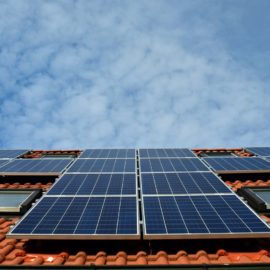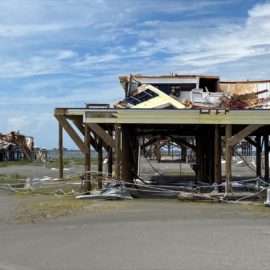
Upper Jefferson Parish lost power and water. It is tough to live with out power but not be be able to flush a toilet? We filled the bathtubs here just in case. They were out for quite a while longer than us.
Elenora Smith didn’t mess around with Hurricane Ida. The 75-year old Metairie resident evacuated before the storm made landfall in Louisiana, heading north to Mississippi to get out of its path. Days later, when she heard that electricity had been restored on her street, Smith figured it was time to head home. But what she found on her return was a house with power, but no water. Nothing came from the tap, and the toilets wouldn’t flush. “I had to go to my sister-in-law’s,” she said. “Not being able to flush the toilet was really big.” Not unlike its epic takedown of the region’s power grid, Hurricane Ida crippled Jefferson Parish’s critical water and sewer infrastructure, leaving parts of the parish without water service for days, and the entire parish was under a boil water advisory for a week. The sewer system was also rendered nearly unusable, leading parish officials to plead for residents to avoid flushing or showering to avoid costly backups. So what actually happened?
nola.com
Ida brought wind and rain and since the levees held the wind was the greatest factor. A Category 4 working on becoming a 5 the winds were high. Trees went down and that caused power issues but also the water ones.
The answer is complex, parish officials say. Trees were the main culprit in disabling the water system. More than 1,000 trees fell in the parish rights of way, with their roots ripping through underground water lines, causing cascading breaks that forced the shut down of the entire east bank water system. As for sewer service, Ida’s winds knocked down a major Entergy transmission line into the New Orleans area, including Jefferson Parish. That cut power to the parish’s vast sewer system, with more than 530 sewer lift stations spread over the parish’s 650 square miles. The crash of those basic utilities, especially in East Jefferson, amounted to an uneasy role reversal for a parish that prides itself on having its act together more than its notoriously dysfunctional neighbor, New Orleans. It wasn’t just inconvenient. The drop in east bank water pressure jeopardized the parish’s ability to fight fires for about two days. It also made the water undrinkable. The situation was dire enough that Parish President Cynthia Lee Sheng pleaded with evacuated residents to stay away, and other officials urged any resident who stayed to leave if they could. “We do not have the services that a basic community has,” Lee Sheng said two days after Ida made landfall on Aug. 29. “Our sewer and water systems are extremely fragile.”
Get out of town, a good message that many took up. Thoughts went back to Katrina.
For the parish officials leading the recovery effort, Ida’s impact was eerily reminiscent to that of Hurricane Katrina, which hit on the exact same day in 2005. But the lack of an evacuation order meant more residents were around to suffer through the aftermath. “The difference with Katrina is hardly anyone was here,” Public Works Director Mark Drewes said. “Nobody was here for weeks.” Inside the federal hurricane protection system, East Jefferson bore the brunt of Ida’s wrath, and the damage to the water system tops the list when it comes to parish-owned infrastructure. As Ida’s punishing winds toppled trees, their roots tore through water pipes. Others nearby lines broke due to the violent shifting of the ground, Drewes said. In all, there were more than 200 water line breaks, Drewes said. Approximately three quarters of that damage was in East Jefferson, which has a heavier tree canopy.
Breaks in the pipes meant pressure was lost as well as losing water. Each problem fed off the other.
The day after the storm, the water system was losing almost 23,000 gallons of water per minute. There were so many breaks that the pressure on the east bank dropped close to zero, well below the 20 pounds per square inch that triggers a boil water advisory. The back-up generators supplying electricity to the water treatment plant were working fine, but with all the water running into the ground and onto streets, there was no way to build pressure. Officials decided to shut down the entire system to rebuild pressure and start repairing areas close to the plant. Then they worked their way outward, Drewes said. Sixteen public and private water crews set to work isolating key breaks by shutting off water to them until they could be repaired, slowly building up the pressure. By the end of the second day, 17 major breaks and dozens of smaller ones had been identified. While restoring water service and lifting the boil water advisory were the ultimate goals, Drewes said getting the pressure up to 40 psi was the first priority. “I told my public works department on that first day, the primary goal for the parish right now is to restore sufficient pressure in the east bank system so (we) can fight fires,” he said.
I know people were upset as they searched for breaks and were not fixing them but how do you fix a pipe if you don’t know where the breaks are? We has the same with Entergy here. In East Jefferson, the lack of water also meant a lack of firefighting capabilities.
That need was evident the same day, when two buildings at the Relais Esplanade Apartments in Kenner burned to the ground in a fire attributed to improper use of a generator. No one was killed, but firefighters had to contend with low water pressure in fighting the fire. Crews had the pressure up to 22 psi by the end of Tuesday, and 43 psi by Wednesday night, easing concerns about fighting fires. By Friday — five days after the storm — pressure was back up to 60 psi, which is in the normal range for the system and well above the threshold to retest the water and lift the boil water advisory, but a procedural hurdle remained. The Louisiana Department of Health required the system to be operating under Entergy power, not generator power, and so it would be another two days before water could be tested. It wasn’t until the next Tuesday, nine days after Ida made landfall, before the advisory was lifted.
The West Bank fared better. They still had water problems as well as power ones.
The west bank’s water system fared better. There were far fewer breaks and the drop in pressure that triggered the boil water advisory was due to an operational decision. One of the system’s three backup generators malfunctioned, causing a voltage spike in the system. With pressure gradually dropping, Water Director Sidney Bazley made the call to briefly shut down all three so they could be turned on together to maintain adequate pressure. “The decision was made: We’re gonna bite that bullet now. We’re gonna turn that generator off, sync them, get the pressure right back up so we can fight fires and we’re gonna have to live with a boil water advisory (on the west bank),” Drewes said. Ultimately, Entergy restored power to the west bank station a day before the east bank station, and the boil water advisory was lifted a day earlier as well.
Jefferson Parish’s size means they will have more people affected than New Orleans. It also means their infrastructure size is greater.
As for Jefferson’s sewer system, Sewer Director Mike Lockwood said its sheer size and reliance on lift stations present challenges. The biggest system in the region, it has 534 lift stations compared to just over 80 in New Orleans. Sewerage moves through the system either by gravity through sloping pipes or pressure created mechanically by the lift stations. Jefferson Parish is flat, and the soil suitable for burying lines is shallow, so it cannot rely as heavily on simple, inexpensive gravity lines to move wastewater the way other regions can. Lockwood said Jefferson’s system has 1,300 miles of gravity lines and “hundreds” of miles of pressure pipes. Sewer lines, however, are often buried deeper than water lines, so the uprooting of trees didn’t damage them as badly. But when Ida knocked out power, only four lift stations equipped with generator power — some of the most crucial to the system — were operable. Lockwood said crews began hooking up portable pumps and generators to additional lift stations as power was restored. There were 105 in service three days after the storm and 217 after a week. Only four remain out today, Lockwood said.
Sewer lines are below water lines so that seepage from the sewer lines will not get into the water. Without power, there would be sewage overflows.
The parish also mobilized vacuum trucks to prevent sewerage overflows, starting with 15 the day after the storm and increasing to 81, with many driving in from as far away as Washington, Minnesota and New Jersey. Drewes and Lockwood said that while the parish’s water and sewer systems never lacked diesel fuel, other resources, such as the vacuum trucks, were in short supply in large part because of the demand from the state’s oil and gas industry.
Any disaster like this leads to needed improvements. I hope New Orleans is also doing this.
The parish has already laid the groundwork for some necessary improvements. Earlier this year, voters renewed the water and sewer millages and have allowed them to return to their original maximums of 5 mills each. And this month, the council approved sewer and water rate increases to fund a 20-year plan to modernize the systems. The parish will bond out $192 million for water system improvements, including replacing old, leaking water lines and upgrading the system’s outdated east bank water plant, where some parts date to the 1930s. There are also funds for modernizing water towers and installing newer meters. About $100 million bond funding will go toward the sewer system, with the first $14 million going to add generators to more than a dozen the highest-priority lift stations that don’t currently have them. Other proceeds will go to upgrade the treatment plant and replace obsolete pipes. “Ida confirmed what we already knew,” Drewes said. “Our system needs to be revamped.”
I am glad they realize the system needs upgrades but why to they always give the utility more of our money by raising our payments. Part of the problem is the utility and we pay for their errors. Nothing new in that! Now to hear what will happen to upgrade in New Orleans.



